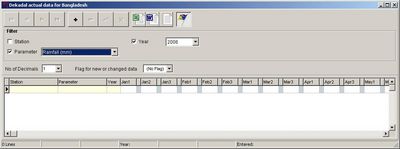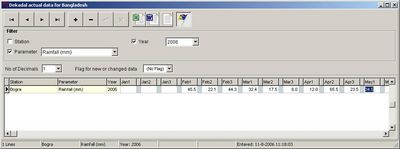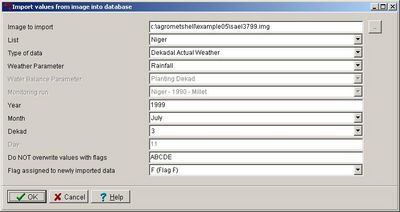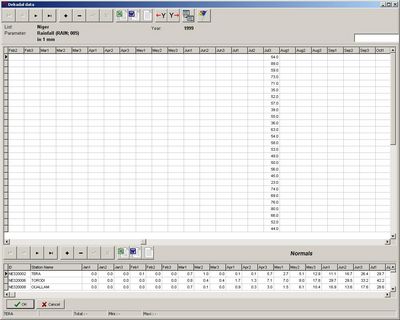[edit]3.1. Entering and importing normal and actual weather data.
Peter Hoefsloot Once a network has been created, data for the network can be entered by hand. This is possible for grid-based networks and station networks alike. However, as grid-based networks do not coincide with a ground network, it will usually not make sense to enter data manually for that type of network. The data are stored in the Microsoft Access database that is maintained by AgrometShell. The name and path of this database can be seen in the top bar of AgroMetShell. Entering data is done in three ways:
- Manually
- Importing from images
- Importing from tabular ASCII data.
All three methods are explained below.
[edit]Option1: Entering weather data manually
As the FAO water balance model is usually run with a 10-day (dekadal) time step, this example will show how to enter dekadal weather data.
All weather data for all time periods (daily, decadal and monthly data) can be entered in the same way. The same applies to normal data.
[edit]Option 2: Entering weather data from images
Weather data derived from satellite imagery are improving every year. The satellite imagery history that has been built up from the eighties now enables the calculation of normals as well. Although satellite derived data cannot be a substitute for ground data, these data are often the only available data.
These satellite-derived data can be used in AgrometShell (for example in a water balance calculation) after importing them. This can be achieved in the following way:
The same function can also be used to import station altitude data from a Digital Terrain Model (DTM).
[edit]Option 3: Importing tabular weather data from ASCII files
In many circumstances data come in a digitized tabular form (ASCII). It would be a long and error-prone procedure to enter these data manually into Agrometshell. Therefore an import module exist that is described here.

| CM Box User Guide | Main Page | About | Special pages | Log in |
Printable version | Disclaimer | Privacy policy |





